The Kaveri Refresh 'Godavari' Review: Testing AMD's A10-7870K
by Ian Cutress on June 1, 2015 11:59 AM ESTGaming Benchmarks: High End
Alien: Isolation
If first person survival mixed with horror is your sort of thing, then Alien: Isolation, based off of the Alien franchise, should be an interesting title. Developed by The Creative Assembly and released in October 2014, Alien: Isolation has won numerous awards from Game Of The Year to several top 10s/25s and Best Horror titles, ratcheting up over a million sales by February 2015. Alien: Isolation uses a custom built engine which includes dynamic sound effects and should be fully multi-core enabled.
For low end graphics, we test at 720p with Ultra settings, whereas for mid and high range graphics we bump this up to 1080p, taking the average frame rate as our marker with a scripted version of the built-in benchmark.
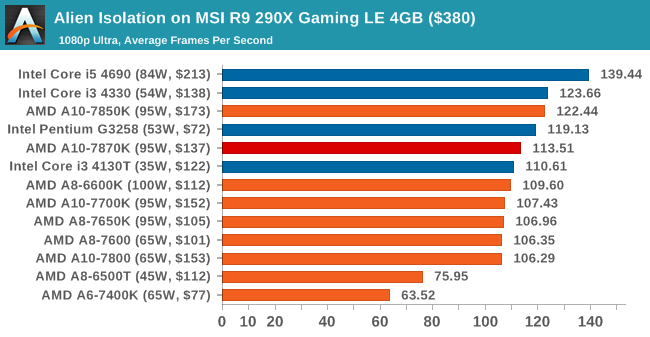

Total War: Attila
The Total War franchise moves on to Attila, another The Creative Assembly development, and is a stand-alone strategy title set in 395AD where the main story line lets the gamer take control of the leader of the Huns in order to conquer parts of the world. Graphically the game can render hundreds/thousands of units on screen at once, all with their individual actions and can put some of the big cards to task.
For low end graphics, we test at 720p with performance settings, recording the average frame rate. With mid and high range graphics, we test at 1080p with the quality setting. In both circumstances, unlimited video memory is enabled and the in-game scripted benchmark is used.

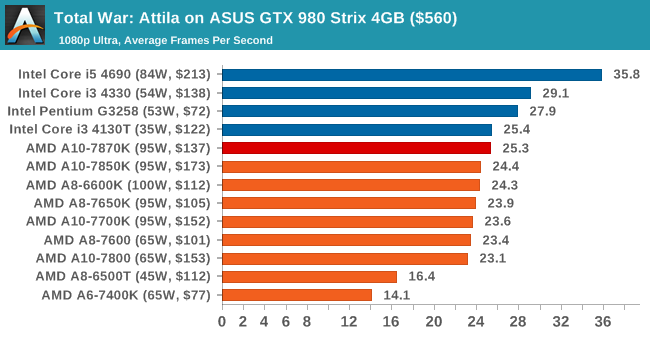
Grand Theft Auto V
The highly anticipated iteration of the Grand Theft Auto franchise finally hit the shelves on April 14th 2015, with both AMD and NVIDIA in tow to help optimize the title. GTA doesn’t provide graphical presets, but opens up the options to users and extends the boundaries by pushing even the hardest systems to the limit using Rockstar’s Advanced Game Engine. Whether the user is flying high in the mountains with long draw distances or dealing with assorted trash in the city, when cranked up to maximum it creates stunning visuals but hard work for both the CPU and the GPU.
For our test we have scripted a version of the in-game benchmark, relying only on the final part which combines a flight scene along with an in-city drive-by followed by a tanker explosion. For low end systems we test at 720p on the lowest settings, whereas mid and high end graphics play at 1080p with very high settings across the board. We record both the average frame rate and the percentage of frames under 60 FPS (16.6ms).
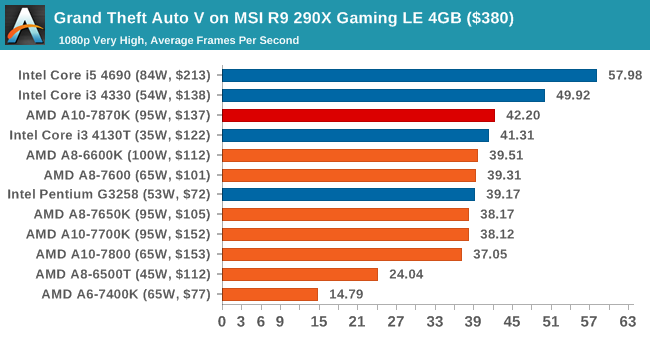
![Grand Theft Auto V on MSI R9 290X Gaming LE 4GB ($380) [Under 60 FPS]](https://images.anandtech.com/graphs/graph9307/74894.png)
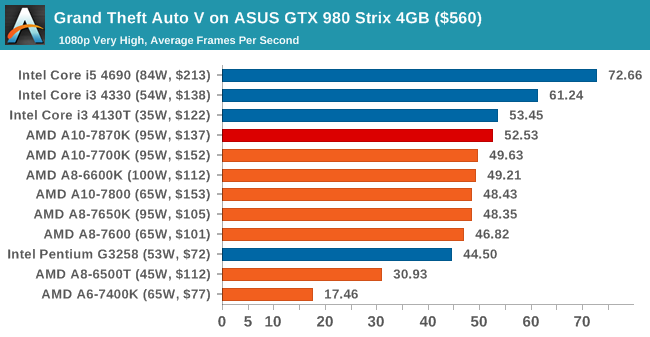
![Grand Theft Auto V on ASUS GTX 980 Strix 4GB ($560) [Under 60 FPS]](https://images.anandtech.com/graphs/graph9307/74906.png)
GRID: Autosport
No graphics tests are complete without some input from Codemasters and the EGO engine, which means for this round of testing we point towards GRID: Autosport, the next iteration in the GRID and racing genre. As with our previous racing testing, each update to the engine aims to add in effects, reflections, detail and realism, with Codemasters making ‘authenticity’ a main focal point for this version.
GRID’s benchmark mode is very flexible, and as a result we created a test race using a shortened version of the Red Bull Ring with twelve cars doing two laps. The car is focus starts last and is quite fast, but usually finishes second or third. For low end graphics we test at 1080p medium settings, whereas mid and high end graphics get the full 1080p maximum. Both the average and minimum frame rates are recorded.
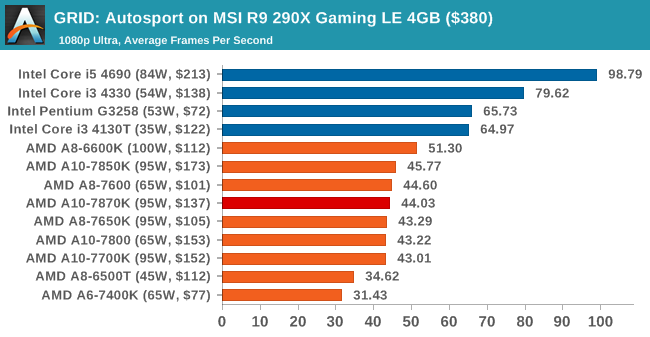
![GRID: Autosport on MSI R9 290X Gaming LE 4GB ($380) [Minimum FPS]](https://images.anandtech.com/graphs/graph9307/74896.png)
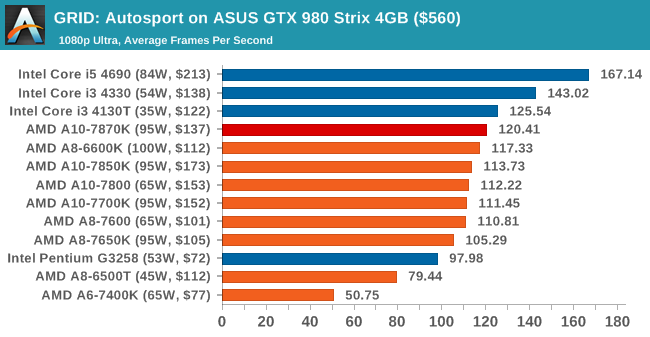
![GRID: Autosport on ASUS GTX 980 Strix 4GB ($560) [Minimum FPS]](https://images.anandtech.com/graphs/graph9307/74908.png)
Middle-Earth: Shadows of Mordor
The final title in our testing is another battle of system performance with the open world action-adventure title, Shadows of Mordor. Produced by Monolith using the LithTech Jupiter EX engine and numerous detail add-ons, SoM goes for detail and complexity to a large extent, despite having to be cut down from the original plans. The main story itself was written by the same writer as Red Dead Redemption, and it received Zero Punctuation’s Game of The Year in 2014.
For testing purposes, SoM gives a dynamic screen resolution setting, allowing us to render at high resolutions that are then scaled down to the monitor. As a result, we get several tests using the in-game benchmark. For low end graphics we examine at 720p with low settings, whereas mid and high end graphics get 1080p Ultra. The top graphics test is also redone at 3840x2160, also with Ultra settings, and we also test two cards at 4K where possible.
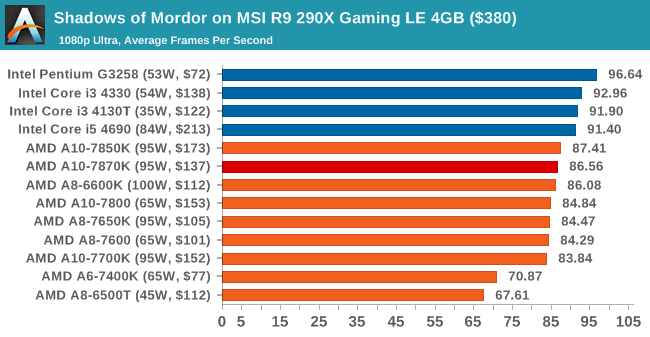
![Shadows of Mordor on MSI R9 290X Gaming LE 4GB ($380) [Minimum FPS]](https://images.anandtech.com/graphs/graph9307/74898.png)
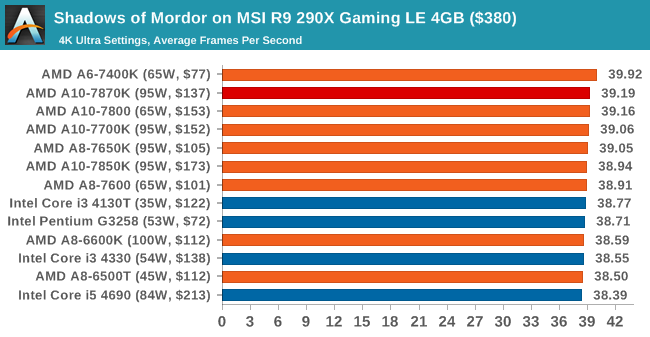
![Shadows of Mordor on MSI R9 290X Gaming LE 4GB ($380) [Minimum FPS]](https://images.anandtech.com/graphs/graph9307/74900.png)
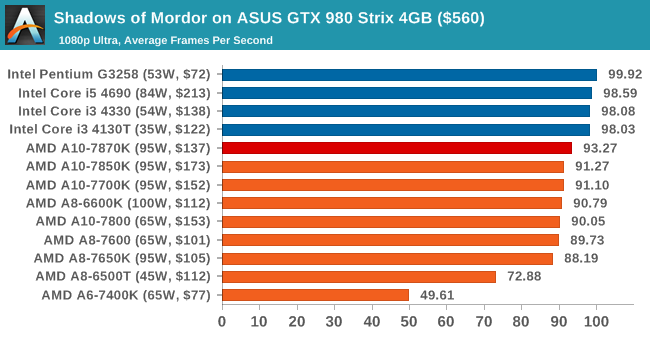
![Shadows of Mordor on ASUS GTX 980 Strix 4GB ($560) [Minimum FPS]](https://images.anandtech.com/graphs/graph9307/74910.png)
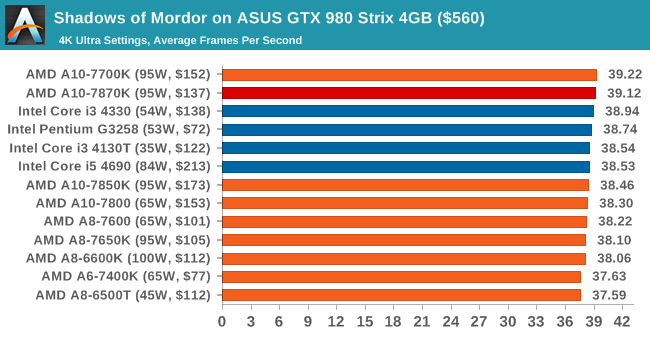
![Shadows of Mordor on ASUS GTX 980 Strix 4GB ($560) [Minimum FPS]](https://images.anandtech.com/graphs/graph9307/74912.png)
Shadows of Mordor, Dual-GPU
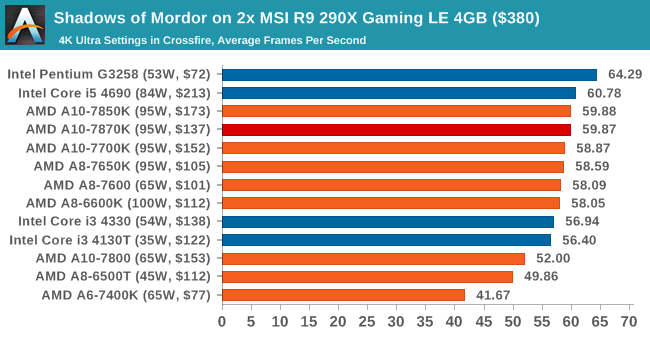
![Shadows of Mordor on 2x MSI R9 290X Gaming LE 4GB ($380) [Minimum FPS]](https://images.anandtech.com/graphs/graph9307/74902.png)
Conclusions on High-End Graphics
Moving to faster GPUs and higher resolutions pushes the burden away from the processor and more onto the graphics cards, so as a result some of the titles here, on some GPU combinations, see little gain moving up through the processor stack. That being said, some titles (like Alien Isolation, GRID and Mordor on a GTX 980) love the horse power under the hood and AMD can have a hard time keeping up here against the blue team. I wouldn’t be surprised if AMD is hoping that DirectX 12 levels the playing field in this regard.















140 Comments
View All Comments
nikaldro - Monday, June 1, 2015 - link
It's funny how most people don't know that they have 2000W washing machines, yet they whine about stuff like this.Oxford Guy - Monday, June 1, 2015 - link
Don't forget the vacuum cleaner amp wars.RafaelHerschel - Tuesday, June 2, 2015 - link
I don't have a washing machine in my livingroom or office and I don't use my washing machine as often as my PC's.Less power means less heat and less noise. It also means better performance in a (very) small case. It also means a more modest PSU.
A fast i3 coupled with a GTX 960 in a Mini ITX case makes for small, potentially quiet system.
Oxford Guy - Monday, June 1, 2015 - link
CPUs and GPUs should have three ratings:1) Standby
2) Average (when in use) (with an industry-wide set of benchmarks)
3) Maximum (also industry-wide benchmarks)
barleyguy - Tuesday, June 2, 2015 - link
My biggest energy usage is definitely climate control. I've switched to LED lightbulbs, and in my kitchen which was a flourescent grid, I'm using an LED rope light. But I have an 80,000 BTU natural gas heater, and 2000 watts worth of air conditioning. Those aren't on constantly since they use a thermostat, but the bulk of my utility bill is definitely represented there. My PVR computer is on 24 hours a day, but probably only represents a couple of dollars of energy usage.Oxford Guy - Monday, June 1, 2015 - link
AMD FX 8320E, Gigabyte UD3P motherboard with 8 phase power and VRM sinks = 161.98 tax incl.Intel i5 4690, MSI Z97 PC Mate (cheap 3 phase + doubler) = $280.78 tax incl.
difference = $118.8
You can use that money to get a refurb EVGA 750 Ti 2 GB from Newegg and have three dollars and 80 cents left over to get an extra 120mm fan for your EVO cooler (which you would get with either processor... no one should use a stock cooler).
Since that AMD processor and motherboard easily overclock to around 4.2 GHz on low voltage (1.27 - 1.3) with a moderate-quality cooler it would be very interesting to see the results in this article coupled with that "free" 750 Ti. Also, one can set the chip to "one core per module" in the BIOS of that motherboard in order to get much higher overclocks (higher voltage but much less heat output) for poorly-threaded applications like most games, which helps a bit to let the chip hang in there with an Intel i5, although you'll likely be GPU bound with a 750 Ti anyway.
Even if you decide to use the stock cooler for the Intel you're still saving some money with the AMD combo -- unless you are going to pair your chip with an expensive GPU.
jann5s - Monday, June 1, 2015 - link
am i the only one amazed by how Otten the 7870 is beat by the 7850???jann5s - Monday, June 1, 2015 - link
Often*Gigaplex - Monday, June 1, 2015 - link
No, you're not the only one. And that's not the only AMD chip it loses to.Cryio - Monday, June 1, 2015 - link
Yep. The results are way off. Both in CPU and GPU.